
Mandsaur is a city and a municipality in Mandsaur district located on the border of Mewar and Malwa regions of Madhya Pradesh, a state in Central India. It is the administrative headquarters of Mandsaur District. The ancient Pashupatinath Temple is located in Mandsaur.

Chhatri are semi-open, elevated, dome-shaped pavilions used as an element in Indo-Islamic architecture and Indian architecture. They are most commonly square, octagonal, and round. Originating as a canopy above tombs, they largely serve as decorative elements as opposed to functional elements. The earliest examples of chhatri being used in the Indian Subcontinent were found in the Shrine of Ibrahim in Bhadreswar, constructed between 1159 and 1175 AD.
Bundi is a city in the Hadoti region of Rajasthan state in northwest India and capital of the former princely state of Rajputana agency. District of Bundi is named after the former princely state.
Nili Chhatri Temple is an ancient Hindu temple in New Delhi, India dedicated to Shiva. It is believed that the eldest Pandava brother, Prince Yudhishthira of Mahabharata, established the temple and the Nigambodh Ghat adjacent to it, and conducted Aswamedha Yajna from here. The temple located in the Yamuna bazaar area close to the Baharadur Shahi Gate of Salimgarh Fort, on Ring Road close to the banks of the Yamuna river exists even today. The temple has been mentioned only infrequently in various chronicles of Delhi.
Kaman or Kamaban is an town located in the Deeg district of Rajasthan. It is historically known to be part of the Braj area, where Krishna is believed to have spent his early life. It is also a part of the historical region of Mewat, comprising the modern-day Bharatpur and Alwar division of Rajasthan.

Yashpal Sharma is an Indian actor primarily working in Hindi-language films and theatre. He is best known for his role as Randhir Singh in Sudhir Mishra's 2003 Hindi movie Hazaaron Khwaishein Aisi, apart from Lagaan (2001), Gangaajal (2003), Ab Tak Chhappan (2004), Apaharan (2005), Lakshyam (2007), Singh Is Kinng (2008), Aarakshan (2011), Rowdy Rathore (2012), and Ayothi (2023).
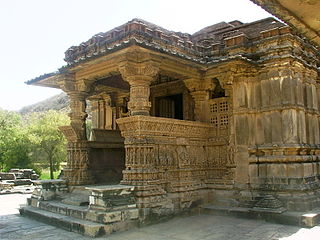
The architecture of the Indian state of Rajasthan has usually been a regional variant of the style of Indian architecture prevailing in north India at the time. Rajasthan is especially notable for the forts and palaces of the many Rajput rulers, which are popular tourist attractions.
The year 1740 in architecture involved some significant events.
Sham Chaurasi Gharana is a vocal gharana in Hindustani classical music known for the singing of vocal duets. It is also known as the cradle of drupad. It is one of the four singing gharanas of Punjab; the other three are: Patiala, Talwandi and Kapurthala. It is most notably represented in modern times by the brothers Nazakat and Salamat Ali Khan.
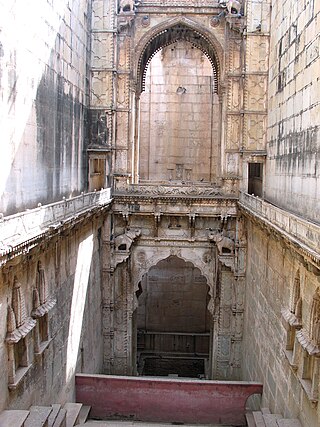
Raniji ki Baori is a noted stepwell situated in Bundi town in Rajasthan state in India. It was built in 1699 by Rani Nathavati Ji Solanki who was the younger queen of the ruling Rao Raja Anirudh Singh of Bundi. It is a 46 meter deep stepped well with some superb carvings on its pillars and a high arched gate. It is a multistorey structure with places of worship on each floor. The step well has a narrow entrance marked by four pillars. Stone elephant statues that face each other stand in the corners. Ogee brackets decorate all the archways of 46 m deep Raniji ki Baori, which is reputedly the largest Baori of Bundi. Baoris were significant social constructions in the medieval Bundi since they acted as assembly areas for the townsfolk. Raniji ki Baori has superb carvings on its pillars and a high arched gate.

Hazaar Chaurasi Ki Maa is a 1998 Indian feature film that deals with the life of a woman who loses her son, a Naxalite, to the violence that is a result of his adopted ideology.
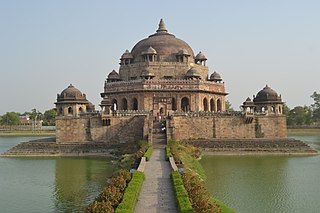
The tomb of Sher Shah Suri is a mausoleum located in Sasaram, in the Indian state of Bihar. Sher Shah Suri, who was the founder of the Sur Empire, commissioned the tomb for himself. It was completed on 16 August 1545, about three months after his death.

Jahaz Mahal, is located next to Hauz-i-Shamsi in Mehrauli, Delhi. It was so named, since its reflection (illusion) in the surrounding reservoir looked like a ship floating on a lake. It is inferred to have been built during the Lodi dynasty period (1452–1526) as a pleasure resort, Sarai or an inn.

Jaswant Singh ki chhatri is a domed pillared pavilion shaped cenotaph, common to Rajasthani architecture, built in c. 1644–58 AD, by Jaswant Singh Rathore in memory of his elder brother Amar Singh Rathore's wife Rani Hada. The chhatri is situated in Rajwara, Balkeshwar, along the banks of river Yamuna, in Agra, and is now maintained by Archaeological Survey of India (ASI) as a monument of National importance.
Balapur Fort is a Mughal fortress in the town of Balapur in the Akola district of India. Construction on the fort was started by Mirza Azam Shah, the son of Emperor Aurangzeb and it was completed by Ismaeel Khan, the Nawab of Elichpur in 1757. The chhatri of Raja Man Singh I, a canopy constructed by Mirza Raja Jaisingh, has an area of 25 square feet and a height of 33 feet. Its foundations were heavily damaged in a great flood called the 'dhvdya pur' which occurred more than 100 years ago, but after some years the damage was repaired at a cost of Rs 3,000 received from Jaipur.
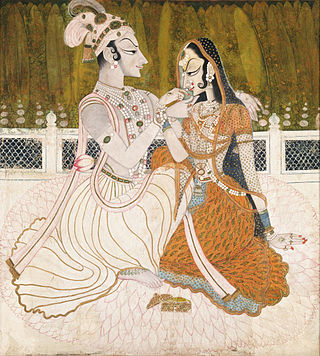
Apart from the architecture of Rajasthan, the most notable forms of the visual art of Rajasthan are architectural sculpture on Hindu and Jain temples in the medieval era, in painting illustrations to religious texts, beginning in the late medieval period, and post-Mughal miniature painting in the Early Modern period, where various different court schools developed, together known as Rajput painting. In both cases, Rajasthani art had many similarities to that of the neighbouring region of Gujarat, the two forming most of the region of "Western India", where artistic styles often developed together.
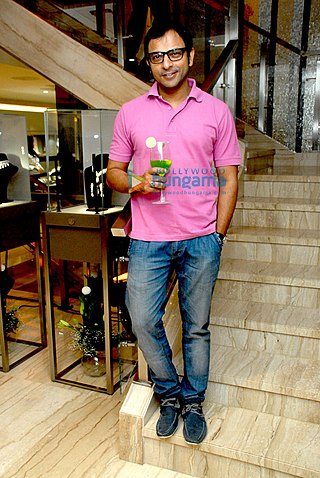
Joy Sengupta is an Indian film and stage actor works Bollywood cinema and Bengali cinema as well as theatre.
Rajgarh is a village in Sangod in Kota district in the Indian state of Rajasthan.
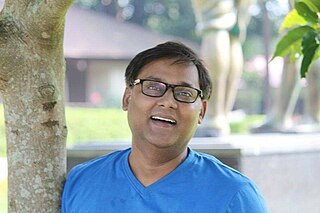
Satya Vyas is an Indian writer of modern Hindi. He is a graduate in Law from Banaras Hindu University. He is born and brought up in Bokaro Steel City and has authored 5 bestselling Hindi Novels.

Nawal Sagar Lake is an artificial lake or reservoir situated in Bundi city in the state of Rajasthan in India. It is surrounded by the hills of the Aravalli mountain range. It is a square shaped artificial lake, and a temple dedicated to Varuna, the God of ocean, is partially submerged in the middle of the lake. Nawal Sagar is surrounded by towering walls and has two gateways that serve as entry points to the lake. It is located in the centre of the Bundi city.














